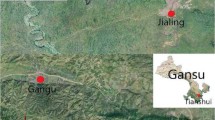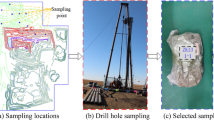Abstract
All rocks undergo creep when under a long-term load, and shear sliding is a major failure mode of natural slopes. However, the mechanical properties of fractured mudstone differ from those of intact rock. To investigate these properties and the influence of normal stress and pre-cut crack length on mudstone shear creep characteristics, we performed shear creep tests on fractured mudstone. The experimental results show that axial load magnitude and crack length have a marked influence on the rock’s shear creep behavior. The larger the axial compressive stress, the smaller the shear creep deformation. The longer the crack, the more significant the shear creep deformation. When stress is low, existing creep models can reflect the creep properties of mudstone well. However, most published creep models cannot accurately portray the nonlinear creep behavior of mudstone in a tertiary creep stage. We propose an improved time-dependent creep model that overcomes the shortcomings of the traditional models in describing nonlinear creep. The new model has fewer parameters and can be applied to practical engineering problems involving soft rock. During the shear creep tests on soft argillaceous samples under different loads, shear failure zones in fractured mudstone exhibited both gradual and sudden failure. The shear time-dependent model for mudstone developed in this study can effectively explain mudstone instability.









Similar content being viewed by others
Abbreviations
- \(\tau_{1}\) :
-
First level of shear loading
- \(\tau_{2}\) :
-
Second level of shear loading
- \(\tau_{4}\) :
-
Fourth level of shear loading
- \(\tau_{5}\) :
-
Fifth level of shear loading
- \(\tau_{\text{s}}\) :
-
Long-term shear strength of the samples
- \(\varepsilon\) :
-
Strain
- \(\varepsilon_{\text{c}}\) :
-
Limit strain (the initial zone) of the improved viscoplastic body (N/St.V)
- \(\eta_{\text{c}}\) :
-
Viscous coefficient of the new creep body for \(\varepsilon < \varepsilon_{\text{c}}\)
- n :
-
Rheological index (> 1)
- \(\eta_{\text{c}}^{'} = \eta_{\text{c}} \left( {{{\varepsilon_{\text{c}} } \mathord{\left/ {\vphantom {{\varepsilon_{\text{c}} } \varepsilon }} \right. \kern-0pt} \varepsilon }} \right)^{n}\) :
-
Viscous coefficient, which is nonlinear for \(\varepsilon \ge \varepsilon_{\text{c}}\)
- \(t_{\text{c}}\) :
-
Time for the model to enter the tertiary creep stage
- t p :
-
Failure time, \(t_{\text{p}} = {{n\eta_{\text{c}} \varepsilon_{\text{c}} } \mathord{\left/ {\vphantom {{n\eta_{\text{c}} \varepsilon_{\text{c}} } {\left( {n - 1} \right)\sigma_{0} }}} \right. \kern-0pt} {\left( {n - 1} \right)\sigma_{0} }}\)
- \(\varepsilon_{\text{H}}\) :
-
Strain of the Hooke body (H)
- \(\varepsilon_{\text{K}}\) :
-
Strain of the viscoelastic body (N/H)
- \(E_{\text{H}}\) :
-
Elasticity modulus of the Hooke body
- \(E_{\text{K}}\) :
-
Elasticity modulus body
- \(\eta_{\text{k}}\) :
-
Viscous coefficients of the Kelvin body for \(\varepsilon_{\text{c}}\)
- \(\eta_{\text{c}}\) :
-
Viscous coefficient of the new creep body
- \(\tau_{\text{s}}\) :
-
Long-term strength
- τ 0 :
-
Shear stress
References
Aydan, O., Ito, T., Ozbay, U., Kwasniewski, M., Shariar, K., Okuno, T., et al. (2014). ISRM suggested methods for determining the creep characteristics of rock. Rock Mechanics and Rock Engineering,47(1), 275–290.
Baud, P., & Meredith, P. G. (1997). Damage accumulation during triaxial creep of Darley Dale sandstone from pore volumometry and acoustic emission. International Journal of Rock Mechanics and Mining Sciences,34(3–4), 24–33.
Berest, P., Blum, P., Charpentier, J., Gharbi, H., & Vales, F. (2005). Very slow creep tests on rock samples. International Journal of Rock Mechanics and Mining,42(4), 569–576.
Bieniawski, Z. T. (1970). Time-dependent behaviour of fractured rock. Rock Mechanics and Rock Engineering,2(3), 123–137.
Boukharov, G. N., Chandi, M. W., & Boukharov, N. G. (1995). The three processes of brittle crystalline rock creep. International Journal of Rock Mechanics and Mining and Geomechanics Abstracts,32(4), 325–335.
Brantut, N., Heap, M. J., Meredith, P. G., & Baud, P. (2013). Time-dependent cracking and brittle creep in crustal rocks: A review. Journal of Structural Geology,52, 17–43.
Chan, K. S. (1997). A damage mechanics treatment of creep failure in rock salt. International Journal of Damage Mechanics,6(2), 122–152.
Fabre, G., & Pellet, F. (2006). Creep and time-dependent damage in argillaceous rocks. International Journal of Rock Mechanics and Mining Sciences,43(6), 950–960.
Gunther, R. M., Salzer, K., Popp, T., & Ludeling, C. (2015). Steady-state creep of rock salt: Improved approaches for lab determination and modelling. Rock Mechanics and Rock Engineering,48, 2603–2613.
Hamza, O., & Stace, R. (2018). Creep properties of intact and fractured muddy siltstone. International Journal of Rock Mechanics and Mining Sciences,106, 109–116.
Hao, S. W., Liu, C., Wang, Y. C., & Chang, F. Q. (2017). Scaling law of average failure rate and steady-state rate in rocks. Pure and Applied Geophysics,174(6), 2199–2215.
Heap, M. J., Baud, P., & Meredith, P. G. (2009a). Influence of temperature on brittle creep in sandstones. Geophysical Research Letters,36, L19305.
Heap, M. J., Baud, P., Meredith, P. G., Bell, A. F., & Main, I. G. (2009b). Time-dependent brittle creep in Darley Dale sandstone. Journal of Geophysical Research,114, B07203.
Huang, R. Q., Wu, L. Z., He, Q., & Li, J. H. (2017). Stress intensity factor analysis and the stability of overhanging rock. Rock Mechanics and Rock Engineering, 50(8), 2135–2142.
Hunsche, U., & Hampel, A. (1999). Rock salt—the mechanical properties of the host rock material for a radioactive waste repository. Engineering Geology,52(3), 271–291.
Kemeny, J. (2003). The time-dependent reduction of sliding cohesion due to rock bridge along discontinuities: A fracture mechanics approach. Rock Mechanics and Rock Engineering,36, 27–38.
Kemeny, J. (2005). Time-dependent drift degradation due to the progressive failure of rock bridges along discontinuities. International Journal of Rock Mechanics and Mining Sciences,42, 35–46.
Lawn, B. R., & Swain, M. V. (1975). Microfracture beneath point indentations in brittle solids. Journal of Materials Science,10, 113–122.
Lo, C. M., & Feng, Z. Y. (2014). Deformation characteristics of slate slopes associated with morphology and creep. Engineering Geology,178, 132–154.
Ma, L., & Daemen, J. J. K. (2006). An experimental study on creep of welded tuff. International Journal of Rock Mechanics and Mining Sciences,43(2), 282–291.
Malan, D. F. (1999). Time-dependent behaviour of deep level tabular excavations in hard rock. Rock Mechanics and Rock Engineering,32(2), 123–155.
Malan, D. F. (2002). Manuel Rocha Medal recipient simulating the time-dependent behaviour of excavations in hard rock. Rock Mechanics and Rock Engineering,35(4), 225–254.
Mallet, C., Fortin, J., Guéguen, Y., & Bouyer, F. (2015). Brittle creep and subcritical crack propagation in glass submitted to triaxial conditions. Journal of Geophysical Research Solid Earth,120, 879–893.
Nishihara, M. (1952). Creep of shale and sandy-shale. Journal of the Geological Society of Japan,58, 373–377.
Nishihara, M. (1957). Rheological properties of rocks. Doshisha Engineering Revision,83, 85–115.
Okubo, S., Fukui, K., & Nishimatsu, Y. (1993). Control performance of servo-controlled testing machines in compression and creep tests. International Journal of Rock Mechanics and Mining Sciences and Geomechanics Abstracts,30(3), 247–255.
Shao, J. F., Zhu, Q. Z., & Su, K. (2003). Modeling of creep in rock materials in terms of material degradation. Computers and Geotechnics,30(7), 549–555.
Silberschmidt, V. G., & Silberschmidt, V. V. (2000). Analysis of cracking in rock salt. Rock Mechanics and Rock Engineering,33(1), 53–70.
Sterpi, D., & Gioda, G. (2009). Visco-plastic behaviour around advancing tunnels in squeezing rock. Rock Mechanics and Rock Engineering,42(2), 319–339.
Wang, J. A., Wang, Y. X., Cao, Q. J., Ju, Y., & Mao, L. T. (2015). Behavior of microcontacts in rock joints under direct shear creep loading. International Journal of Rock Mechanics and Mining Sciences,28, 217–229.
Wu, L. Z., Deng, H., Huang, R. Q., Zhang, L. M., Guo, X. G., & Zhou, Y. (2019). Evolution of lakes created by landslide dams and the role of dam erosion: A case study of the Jiajun landslide on the Dadu River, China. Quaternary International,503A, 41–50.
Wu, L. Z., Li, B., Huang, R. Q., & Sun, P. (2017). Experimental study and modeling of shear rheology in sandstone with non-persistent joints. Engineering Geology,222, 201–211.
Wu, L. Z., Li, B., Huang, R. Q., & Wang, Q. Z. (2016). Study on Mode I–II hybrid fracture criteria for the stability analysis of sliding overhanging rock. Engineering Geology,209, 187–195.
Wu, L. Z., Shao, G. Q., Huang, R. Q., & He, Q. (2018). Overhanging rock: Theoretical, physical and numerical modeling. Rock Mechanics and Rock Engineering,51(11), 3585–3597.
Xu, T., Xu, Q., Tang, C. A., & Ranjith, P. G. (2013). The evolution of rock failure with discontinuities due to shear creep. Acta Geotechnica,8(6), 567–581.
Yang, S. Q., & Cheng, L. (2011). Non-stationary and nonlinear visco-elastic shear creep model for shale. International Journal of Rock Mechanics and Mining Sciences,48(6), 1011–1020.
Yang, C. H., Daemen, J. J. K., & Yin, J. H. (1999). Experimental investigation of creep behavior of salt rock. International Journal of Rock Mechanics and Mining Sciences and Geomechanics Abstracts,36(2), 233–242.
Yang, S. Q., & Jiang, Y. Z. (2010). Triaxial mechanical creep behavior of sandstone. Mining Science and Technology,20(3), 339–349.
Yang, W. D., Zhang, Q. Y., Li, S. C., & Wang, S. G. (2014). Time-dependent behavior of diabase and a nonlinear creep model. Rock Mechanics and Rock Engineering,47(4), 1211–1224.
Zhang, Q. Z., Shen, M. R., Jang, B. A., & Ding, W. Q. (2016). Creep behavior of rocks with rough surfaces. Journal of Materials in Civil Engineering,28, 9.
Zhao, Y. L., Zhang, L. Y., Wang, W. J., Wan, W., & Ma, W. H. (2018). Separation of elastoviscoplastic strains of rock and a nonlinear creep model. International Journal of Geomechanics,18(1), 04017129.
Acknowledgements
The authors thank the National Key R&D Program of China (2018YFC1504702), the National Natural Science Foundation of China (nos. 41672282 and 41472296), and the China Geological Survey (DD20190717). The authors thank Mr. S. H. Li for some suggestions, and the Innovation Team of the Chengdu University of Technology.
Author information
Authors and Affiliations
Corresponding author
Additional information
Publisher's Note
Springer Nature remains neutral with regard to jurisdictional claims in published maps and institutional affiliations.
Rights and permissions
About this article
Cite this article
Wu, L.Z., Li, S.H., Sun, P. et al. Shear Creep Tests on Fissured Mudstone and an Improved Time-Dependent Model. Pure Appl. Geophys. 176, 4797–4808 (2019). https://doi.org/10.1007/s00024-019-02257-6
Received:
Revised:
Accepted:
Published:
Issue Date:
DOI: https://doi.org/10.1007/s00024-019-02257-6




